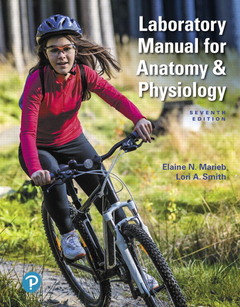Description
Laboratory Manual for Anatomy & Physiology (7th Ed.)
Authors: Marieb Elaine, Jackson Pamela
Language: English
Subjects for Laboratory Manual for Anatomy & Physiology:
Approximative price 102.19 €
In Print (Delivery period: 12 days).
Add to cart392 p. · Paperback
Description
/li>Contents
/li>Biography
/li>Comment
/li>
For two-semester anatomy & physiology lab courses.
A concise, workbook-style approach for a fast-paced A&P lab course
This full-color laboratory manual is designed for instructors who teach a two-semester anatomy & physiology lab course, but do not require the full range of laboratory exercises found in Marieb and Smith?s best-selling Human Anatomy & Physiology Lab Manual (Cat, Fetal Pig, and Main). Written to complement Marieb and Hoehn?s streamlined Anatomy & Physiology, 7th Edition, the manual can be used with any two-semester text.
The 27 concise, activity-based lab exercises explore fundamental concepts in anatomy & physiology and build students? observational and laboratory skills. The manual?s workbook-style approach incorporates visual summary tables, reviews key information, and engages students with hands-on drawing, labeling, and writing activities that can be completed using handy tear-out review sheets. Each lab includes learning objectives and efficient summaries of key concepts, as well as a list of materials needed for conducting the lab.
The 7th Edition adds dozens of new, full-color illustrations and photos plus new critical thinking and clinical application questions to the Exercise Review Sheets. To improve clarity and readability, the headings, exercise tabs, and tables feature more saturated colors.
HUMAN BODY AND ORIENTATION
1. The Language of Anatomy
2. Organ Systems Overview
THE CELL
3. The Cell - Anatomy and Division
4. Cell Membrane Transport Mechanisms
BASIC TISSUES AND THE SKIN
5. Classification of Tissues
6. The Skin (Integumentary System)
THE SKELETAL SYSTEM
7. Overview of the Skeleton
8. The Axial Skeleton
9. The Appendicular Skeleton
10. Joints and Body Movements
THE MUSCULAR SYSTEM
11. Microscopic Anatomy and Organization of Skeletal Muscle
12. Gross Anatomy of the Muscular System
REGULATORY SYSTEMS: NEURAL AND ENDOCRINE
13. Neuron Anatomy and Physiology
14. Gross Anatomy of the Brain and Cranial Nerves
15. Spinal Cord and Spinal Nerves
16. Human Reflex Physiology
17. The Special Senses
18. Functional Anatomy of the Endocrine Glands
THE CIRCULATORY SYSTEM
19. Blood
20. Anatomy of the Heart
21. Anatomy of Blood Vessels
22. Human Cardiovascular Physiology—Blood Pressure and Pulse Determinations
THE RESPIRATORY SYSTEM
23. Anatomy of the Respiratory System
24. Respiratory System Physiology
OTHER MAJOR SYSTEMS
25. Functional Anatomy of the Digestive System
26. Functional Anatomy of the Urinary System
27. Anatomy of the Reproductive System
Histology Atlas
Appendix A: The Microscope
Elaine N. Marieb
After receiving her Ph.D. in zoology from the University of Massachusetts at Amherst, Elaine N. Marieb joined the faculty of the Biological Science Division of Holyoke Community College. While teaching at Holyoke Community College, where many of her students were pursuing nursing degrees, she developed a desire to better understand the relationship between the scientific study of the human body and the clinical aspects of the nursing practice. To that end, while continuing to teach full time, Dr. Marieb pursued her nursing education, which culminated in a Master of Science degree with a clinical specialization in gerontology from the University of Massachusetts. It is this experience that has informed the development of the unique perspective and accessibility for which her publications are known.
Dr. Marieb has given generously to provide opportunities for students to further their education. She funds the E.N. Marieb Science Research Awards at Mount Holyoke College, which promotes research by undergraduate science majors, and has underwritten renovation of the biology labs in Clapp Laboratory at that college. Dr. Marieb also contributes to the University of Massachusetts at Amherst, where she provided funding for reconstruction and instrumentation of a cutting-edge cytology research laboratory. Recognizing the severe national shortage of nursing faculty, she underwrites the Nursing Scholars of the Future Grant Program at the university.
In 2012 and 2017, Dr. Marieb gave generous philanthropic support to Florida Gulf Coast University as a long-term investment in education, research, and training for healthcare and human services professionals in the local community. In honor of her contributions, the university is now home to the Elaine Nicpon Marieb College of Healt
Provide concise workbook-style A&P lab exercises for a fast-paced course.
- Easy-to-follow exercises help students comprehend and retain the material. Exercises include background information, objectives, step-by-step instructions, and efficient tear-out review sheets that can be used for pre-lab or post-lab review.
- Workbook-style, student-friendly design summarizes complex information into visual summary tables and streamlines background information. This approach provides more space for students to write and draw in their lab manual.
- Updated - Photos replace figures to show realistic details and views. For example, Figure 5.2, Epithelial tissues nowprovides a three-dimensional view of organ examples.
Engage students with efficient, tear-out review sheets
- Updated - Dozens of new, full-color illustrations and photos replace many black and white line drawings to help students differentiate among structures and more easily interpret diagrams.
- New - Clinical Application Questions have been added to the Exercise Review Sheets and challenge students to apply lab concepts and critical thinking skills to realworld clinical scenarios.
Help students visualize anatomical structures and physiological concepts
- The book’s art program uses rich, vibrant colors; 3D realistic rendering; and includes brand-new cadaver and histology photos.
- A full-color, 55-plate Histology Atlas provides references to the photomicrographs found in appropriate figure legends throughout the lab manual.
- Improved - Interior design incorporates more saturated colors in headings and exercise tabs to improve readability.




